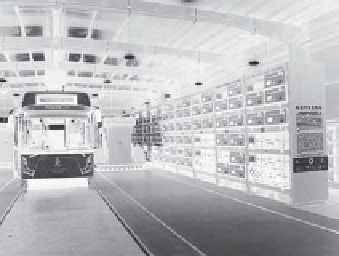Environmental Engineering Reference
In-Depth Information
Figure 2.43 Trolley bus example and Beijing Olympics battery-electric bus
2.8.1 The E4 system
A hybrid propulsion architecture that physically decouples the ICE propulsion and
electric propulsion systems is an electric four wheel drive, or all wheel drive system.
In the E4 architecture the existing ICE driveline remains unchanged, except perhaps
for up-rated electrical generation. The electric drive system is then implemented on
the non-driven axle as illustrated in Figure 2.44, where the M/G is connected to the
axle through a gear ratio and differential. Depending on design, a clutch at the
gearbox input may be necessary to mitigate the effects of M/G spin losses.
Alt.
Power
inverter
e-mtr
Gear
Energy
storage
Figure 2.44 Electric four wheel drive architecture
It is also interesting to investigate the range of options in an E4 system. Not
only are the axle power levels variable in the range from 10 to 25 kW, but the
amount of storage dedicated to E4 is variable from 0 to 1 kWh or higher. To explain
power level demands, it is only necessary to realize that four wheel drive on
demand systems are not engaged frequently and when it is engaged the power level
rarely exceeds 20 kW on passenger sedans to medium and full sized SUVs. This is
a case of a little traction on the non-driven axle being far better than no traction.
A more interesting concept is the fact that E4 can be implemented as a com-
pletely autonomous system with stand-alone transient energy storage to a fully
integrated system sharing energy storage with the main hybrid propulsion system.
































































